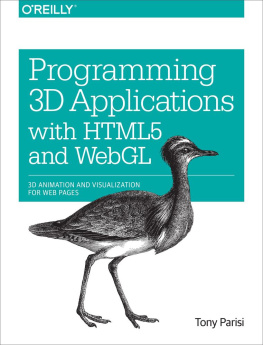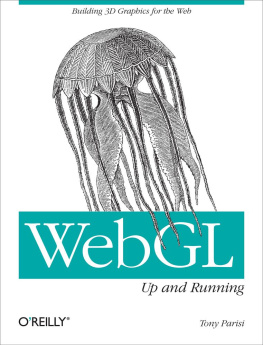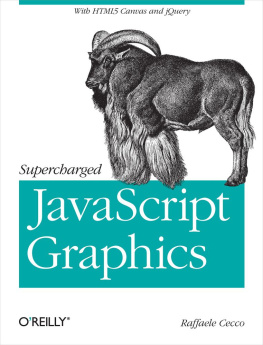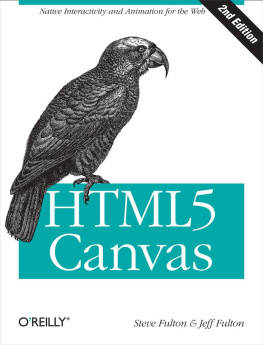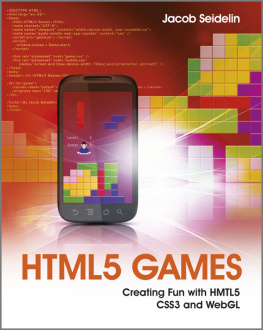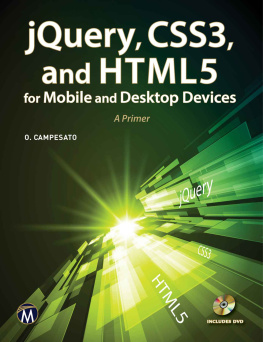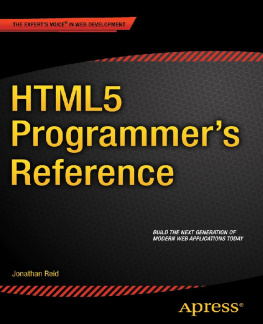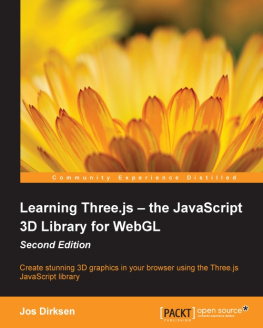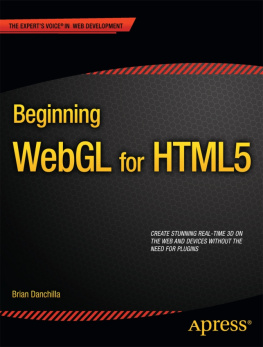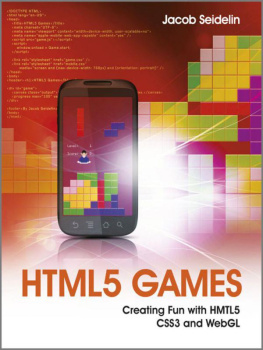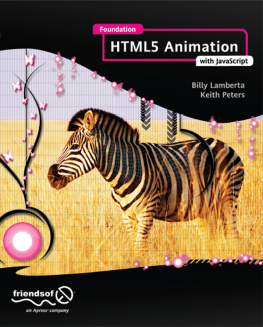Programming 3D Applications with HTML5 and WebGL
Tony Parisi
Preface
In its roughly twenty years of existence, 3D on the Web has taken a tortuous journey. In 1994 it was a Next Big Thing called VRML that grabbed industry attention, only to ultimately become a bastard stepchild of mainstream web development during the first Internet boom. Around 2000, a new Next Big Thing called Shockwave 3D promised to democratize game development; by 2004, that offspring was also shipped off to the orphanage. In 2007, the virtual world system Second Life leapfrogged the technology media establishment, landing on the cover of BusinessWeek , and a new 3D land grab ensuedliterally, as folks rented Second Life islands in droves attempting to colonize a cyberspace that never quite materialized. By 2010, virtual worlds were yesterdays news, as consumers latched on to social and mobile gaming to sate their appetite for distraction. Viewed through one lens, this is a litany of failure. Viewed through another, it is a crucible.
Good ideas may take a long time, but they never truly die. 3D on the Web is one such notion. Once you look past the well-meaning but nave overreaches of those early attempts, you can see what some of us (in all humility) have known all along: 3D is just another media type. Whether you use it to build a massively multiplayer online game, an interactive chemistry lesson, or any of countless other applications, 3D is just another way to get pixels moving on a screen at the behest of the user. Thankfully, the latest generations of browser makers get this, and have been slowly and steadfastly turning the web browser into a rich media development platform that includes first-rate, hardware-accelerated graphics and an integrated compositing architecture. Put in less flowery words: 3D is here; get used to it.
This book is intended to provide you with the information you need to create production-quality 3D applications for desktop and mobile browsers using graphics technologies available in modern browsers: WebGL, Canvas, and CSS3. It covers related topics such as JavaScript performance, mobile development, and high-performance web design; and it goes deep into tools and libraries that will help make you productive: Three.js, Tween.js, new application frameworks, and the many options for 3D content creation.
Readers of my first book, WebGL Up and Running , will see a fair amount of overlap between that book and the early chapters of this one. This is unavoidable. Much of the material in the early chapters is overview and introductory; as such, it must stand on its own without requiring readers to get the earlier book. Regardless, despite the superficial similarities in the early chapters, readers of the first book will find much additional information. Even the introductory chapters here go far deeper into the material than the first book could afford, given its mission. And once we get past the initial three chapters, the material is almost completely different. WebGL Up and Running was intended to provide readers with an approachable introduction to a new and daunting subject. I like to think that what it lacked in technical rigor, it made up for in enthusiasm; if you came away from reading it with nothing other than an appetite to learn more, I consider my job well done. On the other hand, this book aims to give readers a thorough grounding in both theory and practice, allowing them to emerge from the experience ready to build production 3D applications.
Audience
This book was written for experienced web developers looking to move into 3D development. It assumes that you are an intermediate-level developer with a solid grounding in HTML, CSS, and JavaScript, and at least working familiarity with jQuery. You do not need 3D graphics or animation experience, though it will be helpful. The book provides a basic 3D primer, and explains additional concepts as needed throughout.
How This Book Is Organized
This book is divided into two parts:
, explores the underlying HTML5 APIs and technologies for developing 3D graphics in a browser, including WebGL, Canvas, and CSS3.
provides an introduction to 3D application development and 3D graphics core concepts.
Chapters dive into WebGL-based programming, covering the core API as well as two popular open source libraries used to develop graphics and animations: Three.js and Tween.js.
looks at the new features in CSS3 for creating 3D page effects and user interfaces.
describes the 2D Canvas API, and how it can be used to emulate 3D effects on resource-challenged platforms.
, goes hands-on into practical development topics, including the 3D content creation pipeline, programming using application frameworks, and deploying on HTML5 mobile platforms.
covers the content creation pipelinetools and file formats used by artists to create 3D models and animations.
looks at using frameworks to accelerate 3D development and introduces Vizi, an open source framework for creating reusable 3D components.
Chapters dig into developing specific types of 3D applications: simple applications, oriented toward presenting a single interactive object with animations and interaction; and complex 3D environments with sophisticated navigation and multiple interacting objects.
explores issues related to programming 3D applications for the new generation of HTML5-enabled mobile devices and operating systems.
Conventions Used in This Book
The following typographical conventions are used in this book:
ItalicIndicates new terms, URLs, email addresses, filenames, and file extensions
Constant widthUsed for program listings, as well as within paragraphs to refer to program elements such as variable or function names, databases, data types, environment variables, statements, and keywords
Constant width boldShows commands or other text that should be typed literally by the user
Constant width italicShows text that should be replaced with user-supplied values or by values determined by context
Note
This element signifies a general note.
This Books Example Files
You can download all of the code examples for this book from GitHub at the following location:
| https://github.com/tparisi/Programming3DApplications |
Note that you must load most of the examples in this book from a web server rather than opening them from the desktop using file:// URLs. This is because the JavaScript code loads additional content assets, such as image files in JPEG or PNG format; because of cross-origin security restrictions in WebGLs security model, those files must be delivered to the browser from a web server via HTTP.
I run a local version of a standard LAMP stack on my MacBook, but all you really need is the A part of LAMPthat is, a web server such as Apache. Or, if you have Python installed, another option is the SimpleHTTPServer module, which you can run by going to the root of the examples directory and typing:
python -m SimpleHTTPServer
and then pointing your web browser at http://localhost:8000/ . There is a great tech tip on this feature at the Linux Journal website.
In the example files you will find the completed versions of the applications built in the book, which will contain all the code required to run them. In a few cases you will need to download additional content files, such as 3D models, from their original sites before running the application; consult the

